Why a Portable Air Conditioner is Essential for Your Grow Tent
Importance of Maintaining Optimal Temperature and Humidity
Maintaining the right temperature in your grow tent is essential for healthy plant growth, and choosing the best portable air conditioner for a grow tent can make all the difference. Whether you need a compact AC unit, a dual-hose system, or an energy-efficient option, the right cooling solution ensures your plants thrive in a controlled environment. In this guide, we’ll explore top-rated portable air conditioners for grow tents, key features to consider, and expert tips for maintaining the ideal climate.
The ideal temperature for most plants in a grow tent ranges between 70°F to 85°F (21°C to 29°C), while humidity levels should typically be maintained between 50% and 60%. Too high or too low of a temperature or humidity level can hinder plant growth and lead to various problems, such as wilting, yellowing, or even plant death.
A portable air conditioner plays a vital role in ensuring your grow tent stays within these optimal temperature and humidity ranges, especially when external conditions are unpredictable or extreme. Unlike regular fans or ventilation systems, portable AC units can actively cool the air, reduce humidity, and provide a more controlled environment for plants.
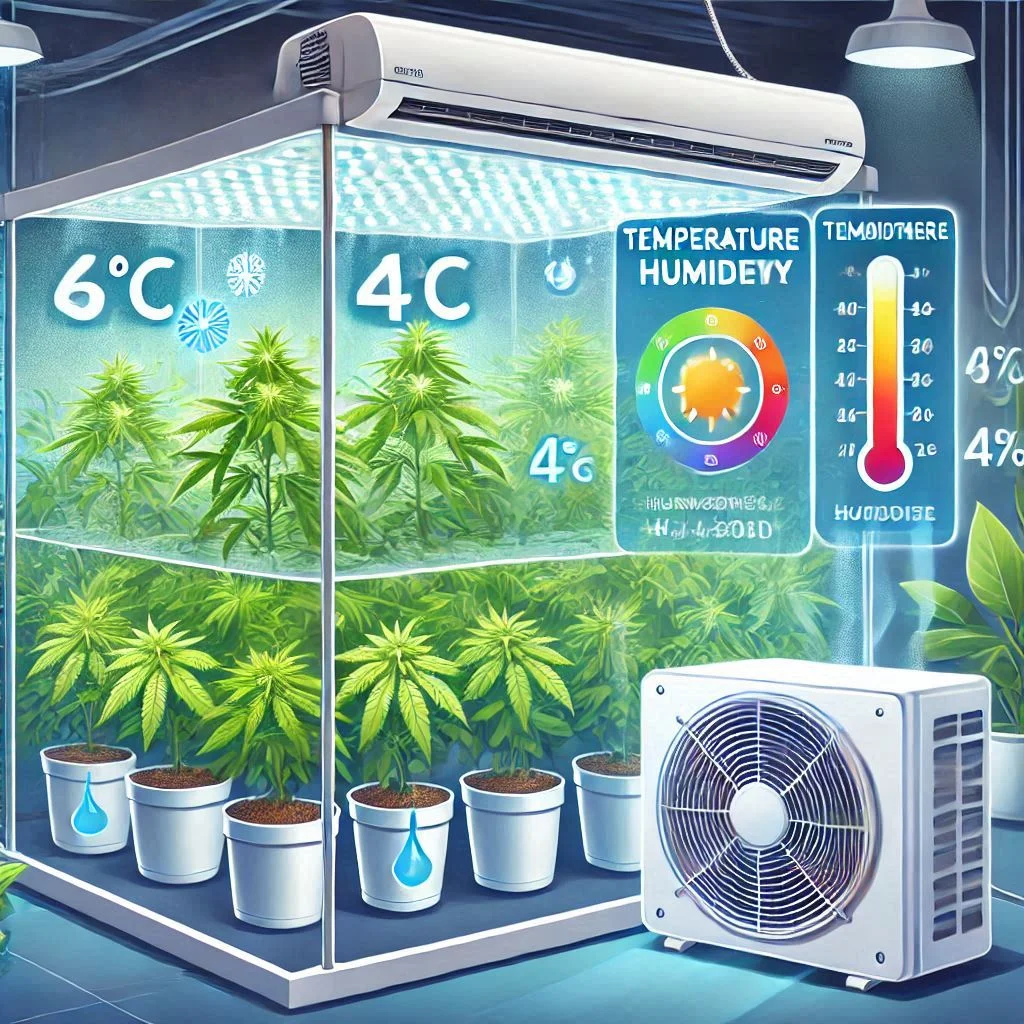
Benefits of Using Portable AC for Grow Tents
- Precise Temperature Control
Portable air conditioners offer precise temperature control, making them ideal for managing the warmth in a grow tent. Plants are sensitive to temperature fluctuations, and portable AC units help ensure that the environment remains stable. This precise control reduces the risk of overheating and ensures that plants receive the appropriate warmth they need to flourish, particularly in summer months. - Enhanced Humidity Control
Most portable air conditioners not only cool the air but also dehumidify it. This is particularly beneficial in a grow tent where high humidity levels can encourage mold, mildew, and root rot. By reducing excess moisture in the air, a portable AC helps maintain a healthy balance and minimizes the risk of harmful fungi or bacteria affecting your plants. - Portability and Flexibility
One of the greatest advantages of a portable air conditioner is its portability. Unlike traditional AC systems, which require permanent installation and may be too large for a grow tent, portable AC units are easy to move around. This flexibility allows you to position the unit wherever it’s needed most, ensuring the air is directed where it will have the most impact on cooling and humidity control. - Energy Efficiency
Modern portable air conditioners are designed to be energy efficient, consuming less power while still providing effective cooling. This can help reduce electricity costs compared to traditional air conditioning systems or running multiple fans. Given that grow tents often need to maintain a stable climate for extended periods, using a portable AC unit ensures that your energy consumption is optimized. - Quiet Operation
Portable AC units are often designed to run quietly, which is ideal for grow tents where noise levels may disrupt plants or your peace of mind. Quiet operation allows you to enjoy the benefits of cooling and dehumidifying without causing excessive noise pollution in your space. - Improved Plant Health and Growth
With the help of a portable air conditioner, plants in a grow tent will be exposed to a more favorable environment, resulting in stronger, healthier growth. Consistent temperatures and humidity can encourage better flowering, fruiting, and overall vitality. Plants grow faster, more uniformly, and are more resilient to diseases and pests in controlled environments. - Cost-Effective Solution
Compared to more expensive, complex HVAC systems, portable air conditioners are relatively affordable and cost-effective. For smaller grow tents or personal gardening setups, this makes portable air conditioning a practical investment. It provides essential cooling and dehumidification without the high installation and maintenance costs of other systems.
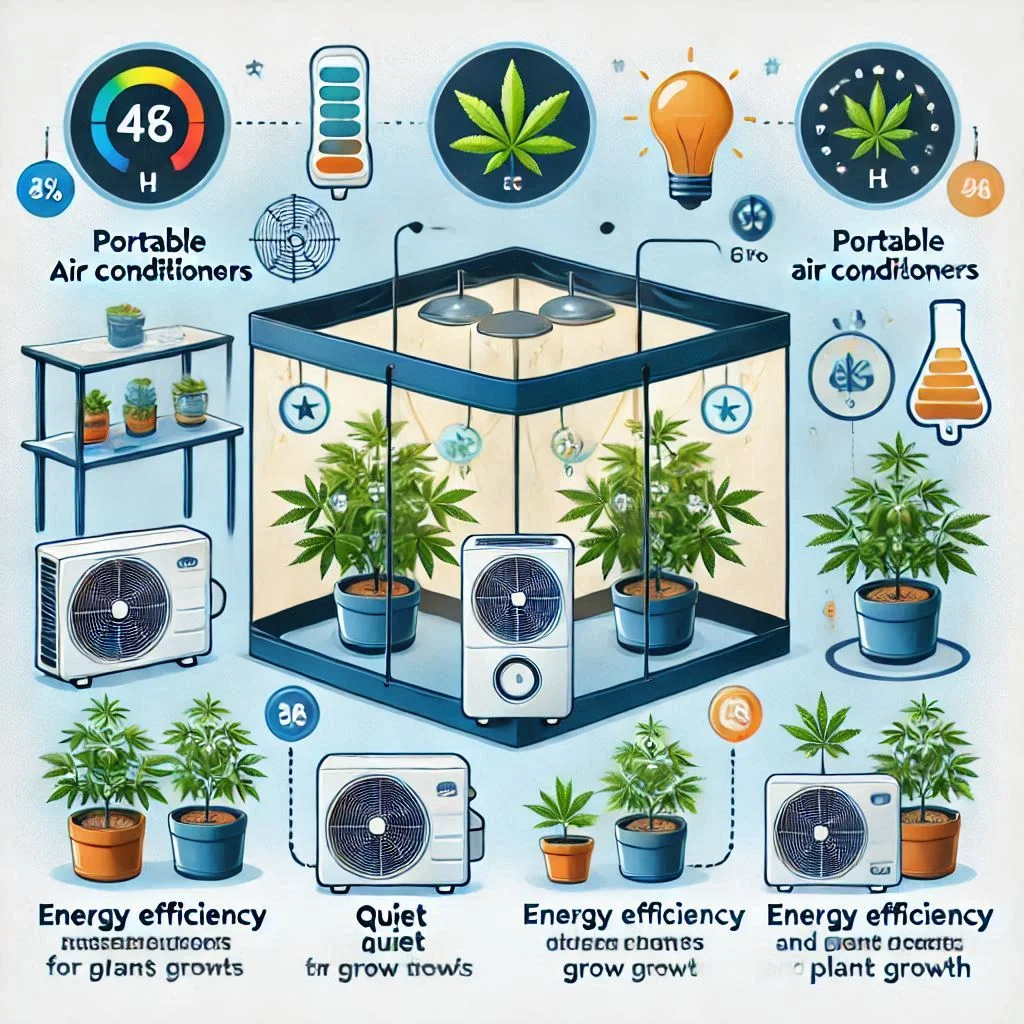
Top Features to Look for in the Best Portable Air Conditioner for Grow Tent
Choosing the best portable air conditioner for your grow tent involves understanding the key features that will impact your plants’ environment and your overall setup. Below are the essential features to consider when selecting a portable AC for your grow tent, each of which can optimize your plants’ growth conditions and enhance your experience.
1. Cooling Capacity and Energy Efficiency
The cooling capacity of an air conditioner is one of the most important factors to consider. Measured in BTUs (British Thermal Units), the cooling capacity determines how much space the unit can effectively cool. The higher the BTU, the larger the area it can cool. For a grow tent, it’s crucial to choose an air conditioner with a suitable BTU rating to ensure it maintains the desired temperature without overworking or underperforming.
- Recommended BTU for Grow Tents:
- For small grow tents (up to 50 sq. ft.), look for air conditioners with 5,000–6,000 BTU.
- For medium-sized tents (50–100 sq. ft.), choose units with 6,000–8,000 BTU.
- Larger grow tents (over 100 sq. ft.) will need 10,000 BTU or more to provide adequate cooling.
Beyond cooling, energy efficiency is crucial, as running a portable air conditioner for extended periods can lead to high energy bills. Look for models with Energy Star certification or units that offer eco-friendly cooling modes to reduce power consumption while maintaining optimal cooling performance. Inverter technology is another feature that enhances energy efficiency by adjusting the compressor’s speed based on cooling needs.
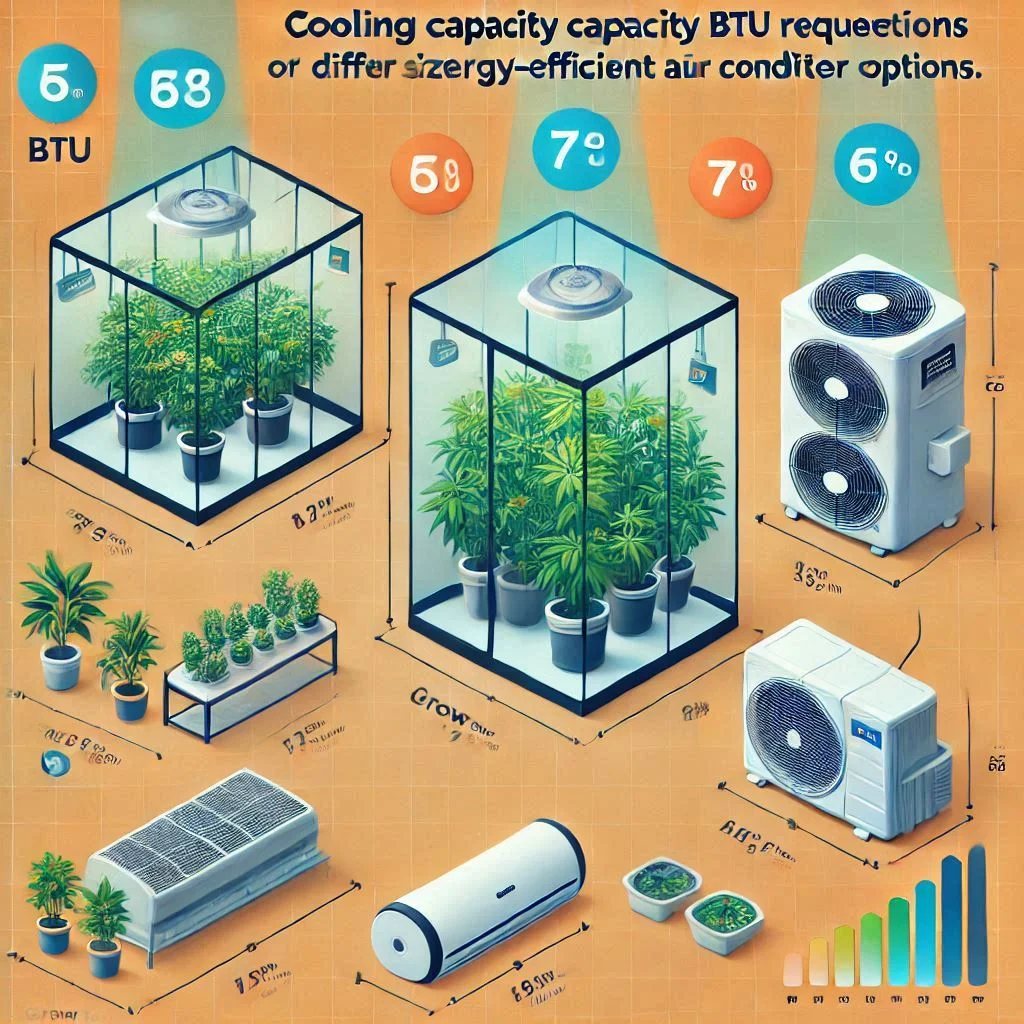
2. Noise Levels and Portability
Noise levels and portability are also vital considerations, especially if your grow tent is in a space where noise could be disruptive. Many grow tent setups are in bedrooms, basements, or apartments, where loud noises from appliances could be annoying.
- Noise Levels: Look for a unit that operates at 55-60 decibels (dB) or lower, as this range provides quiet cooling without disturbing your daily activities. Some portable AC units are specifically designed with noise-reducing technology or low-noise fans to ensure a peaceful growing environment for both you and your plants.
- Portability: The best portable AC units should be easy to move, especially if you need to adjust their position within your grow tent. Features like rolling casters, lightweight design, and easy-to-handle handles enhance portability, allowing you to set up and relocate the AC unit effortlessly. A unit with compact dimensions will be less intrusive in a small tent and won’t take up valuable growing space.
3. Size and Adjustability for Small and Medium-Sized Tents
The size and adjustability of a portable air conditioner are essential for ensuring that it fits comfortably within your grow tent and provides optimal air distribution.
- Size: For small to medium-sized tents (from 50 sq. ft. to 100 sq. ft.), a compact portable air conditioner is ideal. Units that are too large may create excessive cold spots or use more energy than necessary, while units that are too small may fail to maintain the required temperature, leading to stress for your plants. Be sure to check the dimensions of the air conditioner and compare them to the available space in your tent.
- Adjustability: The adjustable airflow feature is important for directing cool air where it’s most needed. A unit with adjustable louvers or directional vents ensures that cool air is spread evenly across the tent, which is especially important if you have multiple plants or different climate zones within the tent. Some units come with remote controls or smart settings, allowing you to make real-time adjustments without having to be physically present in the tent.
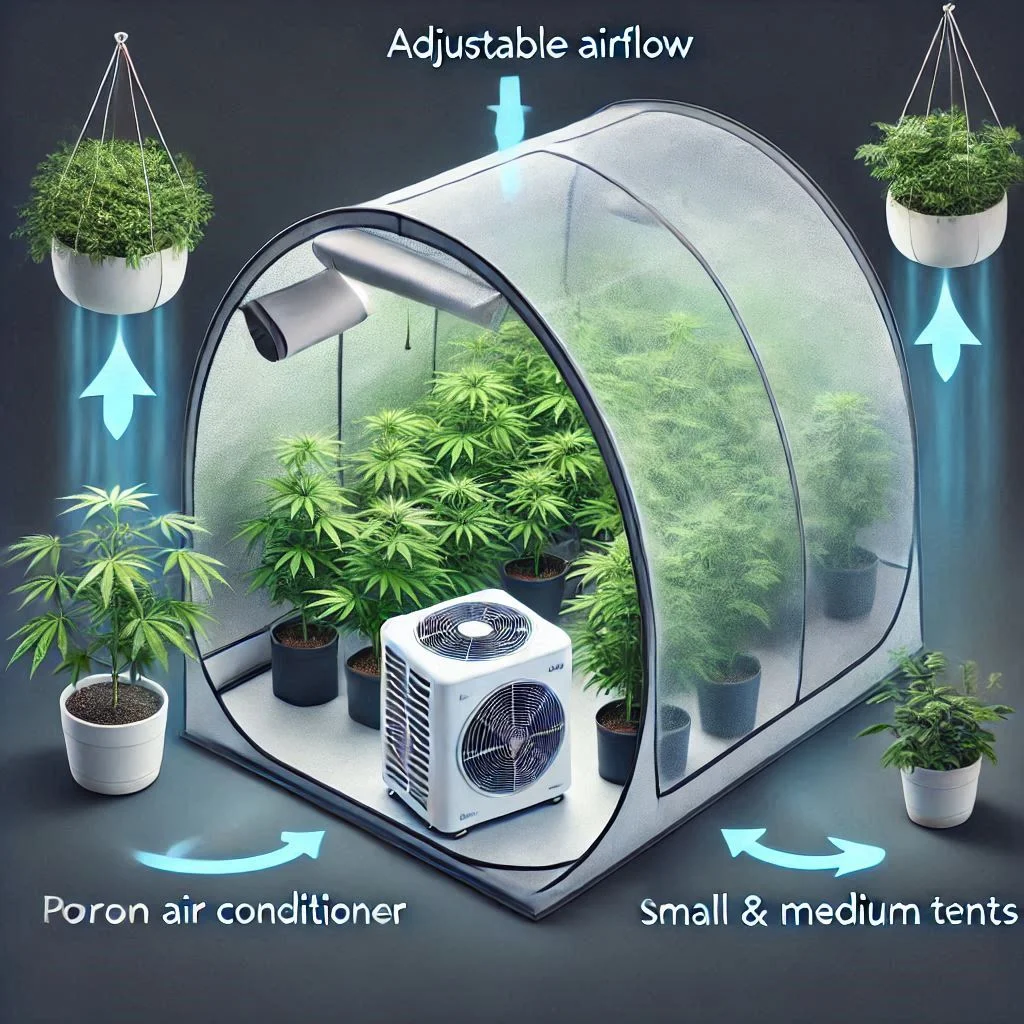
Top 5 Portable Air Conditioners for Grow Tents in 2025
When selecting the best portable air conditioner for your grow tent in 2025, it’s important to look for models that combine high cooling capacity, energy efficiency, and quiet operation to maintain an ideal environment for your plants. In this section, we will explore the top-rated portable air conditioners for grow tents, along with a comparison of their features, pros, and cons to help you make an informed decision.
1. Whynter ARC-14S 14,000 BTU Dual Hose Portable Air Conditioner
The Whynter ARC-14S is one of the most powerful and efficient portable AC units available for grow tents. With a 14,000 BTU cooling capacity, it’s perfect for medium to large-sized grow tents (up to 500 sq. ft). It features a dual hose system that provides faster cooling and better airflow efficiency.
- Key Features:
- Dual hose system for faster cooling
- Energy Star rated for efficiency
- Built-in dehumidifier function
- 14,000 BTU cooling capacity
- Auto-restart feature after power loss
- Pros:
- Powerful cooling for large spaces
- Energy-efficient operation
- Built-in dehumidifier helps manage humidity levels
- Quiet operation (52-56 dB)
- Cons:
- Larger size might not fit in small tents
- Higher price point compared to smaller models
- Requires proper ventilation for dual hose installation

2. Honeywell MN10CES 10,000 BTU Portable Air Conditioner
The Honeywell MN10CES is an excellent option for small to medium-sized grow tents (up to 400 sq. ft.). It is known for its compact design and reliable performance, providing sufficient cooling without occupying too much space.
- Key Features:
- 10,000 BTU cooling capacity
- Built-in dehumidifier
- Auto-evaporation for low maintenance
- Easy-to-install window kit included
- Quiet operation (53 dB)
- Pros:
- Energy-efficient
- Compact and easy to move
- Includes a window venting kit for installation
- Quiet operation suitable for residential spaces
- Cons:
- May struggle to cool larger tents during extreme heat
- Limited cooling capacity for large setups
3. BLACK+DECKER BPACT14HWT 14,000 BTU Portable Air Conditioner
The BLACK+DECKER BPACT14HWT is another 14,000 BTU unit perfect for medium-sized to large grow tents. It provides cooling, heating, and dehumidifying functions, making it an ideal choice for those who need temperature control year-round.
- Key Features:
- 14,000 BTU cooling capacity
- Built-in heat pump for heating functionality
- Dehumidifier mode to control humidity
- Auto mode for temperature control
- Remote control for convenience
- Pros:
- Dual-purpose: can cool and heat
- Excellent cooling capacity for larger tents
- Includes dehumidifier for controlling moisture
- Quiet and efficient
- Cons:
- Slightly bulky for smaller tents
- Can be more expensive due to added heating functionality
- Needs regular maintenance to ensure proper functioning
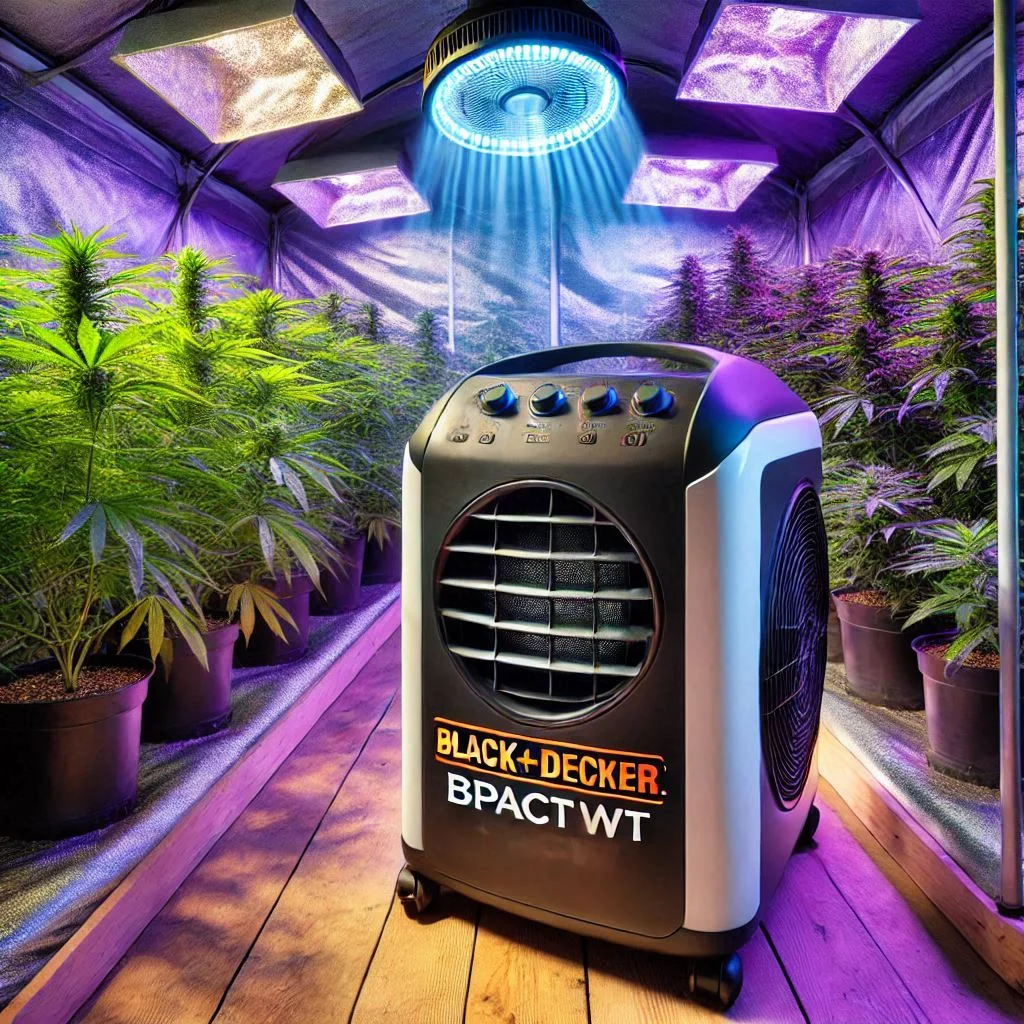
4. LG LP1419IVSM 14,000 BTU Portable Air Conditioner with Inverter Technology
The LG LP1419IVSM is equipped with inverter technology, which allows for energy-efficient cooling and precise temperature control. Its 14,000 BTU cooling capacity makes it ideal for medium to large grow tents.
- Key Features:
- 14,000 BTU cooling capacity
- Inverter technology for energy-efficient operation
- Wi-Fi connectivity for smart controls via mobile app
- Quiet operation (under 54 dB)
- Auto-restart function after power outages
- Pros:
- Energy-efficient with inverter technology
- Smart home integration via mobile app
- Quiet operation, perfect for indoor environments
- Easy to set up and maintain
- Cons:
- Higher upfront cost
- Larger footprint compared to smaller models
5. Delonghi PACAN140H 14,000 BTU Portable Air Conditioner
The Delonghi PACAN140H is another highly-rated 14,000 BTU unit that doubles as both an air conditioner and a heater, making it versatile for grow tents across different seasons. It is specifically designed for medium-sized grow tents and ensures year-round climate control.
- Key Features:
- 14,000 BTU cooling capacity
- Heating function for year-round use
- Self-evaporative system for easy maintenance
- Quiet operation (53 dB)
- Eco-friendly refrigerant
- Pros:
- Dual functionality (cooling and heating)
- Self-evaporating feature reduces the need for draining water
- Energy-efficient cooling and heating
- Quiet and easy to move
- Cons:
- Large size, not ideal for small tents
- Higher price point compared to basic models
How to Properly Set Up a Portable Air Conditioner in Your Grow Tent
Setting up a portable air conditioner (AC) in your grow tent is essential for creating an optimal environment for your plants. A well-cooled grow tent ensures that your plants can thrive in controlled conditions. In this guide, we’ll provide a step-by-step installation process and tips for maximizing efficiency and airflow to help you achieve the best possible results.
Step 1: Choose the Right Location for Your Portable AC
The placement of your portable AC is one of the most important aspects of installation. It affects airflow, cooling efficiency, and the comfort of your plants. Here’s what to consider when choosing the ideal spot:
- Near an exhaust vent or window: Ensure the exhaust hose has a clear path to vent hot air outside the grow tent. Position the AC close to a window or venting port to make installation easier.
- Away from plants and humidity sources: Keep the AC at least 2 feet away from the plants and water sources. Placing it too close to the plants may restrict airflow and affect their growth.
- Access to power outlets: Make sure your AC unit has access to a power source. Consider using an extension cord if needed, but ensure it’s safe and rated for high power appliances.
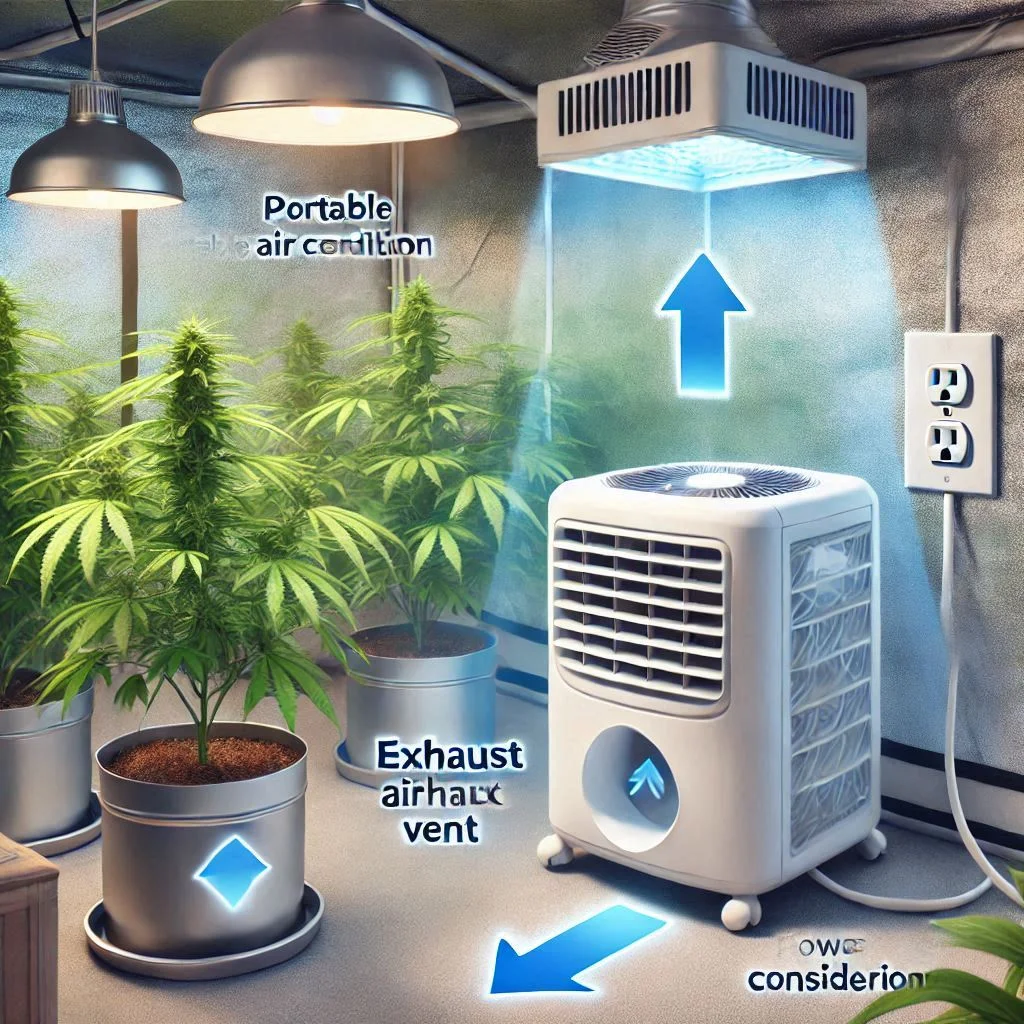
Step 2: Install the Exhaust Hose
Once you have the AC in the right location, the next step is to install the exhaust hose to vent the hot air out of the grow tent. This is a crucial step for maintaining a cool environment for your plants.
- Attach the exhaust hose to the AC unit: Most portable air conditioners come with a flexible exhaust hose that connects to the back of the unit. Ensure the connection is tight and secure to prevent hot air from leaking into the tent.
- Route the exhaust hose outside the tent: Use the window kit or venting kit to route the exhaust hose outside. If you’re using a window kit, open the window and secure the adapter in place, allowing the hot air to escape.
- Ensure a smooth, straight path: Avoid sharp bends in the hose to ensure proper airflow. If the hose is kinked or bent, the efficiency of the AC will be reduced.
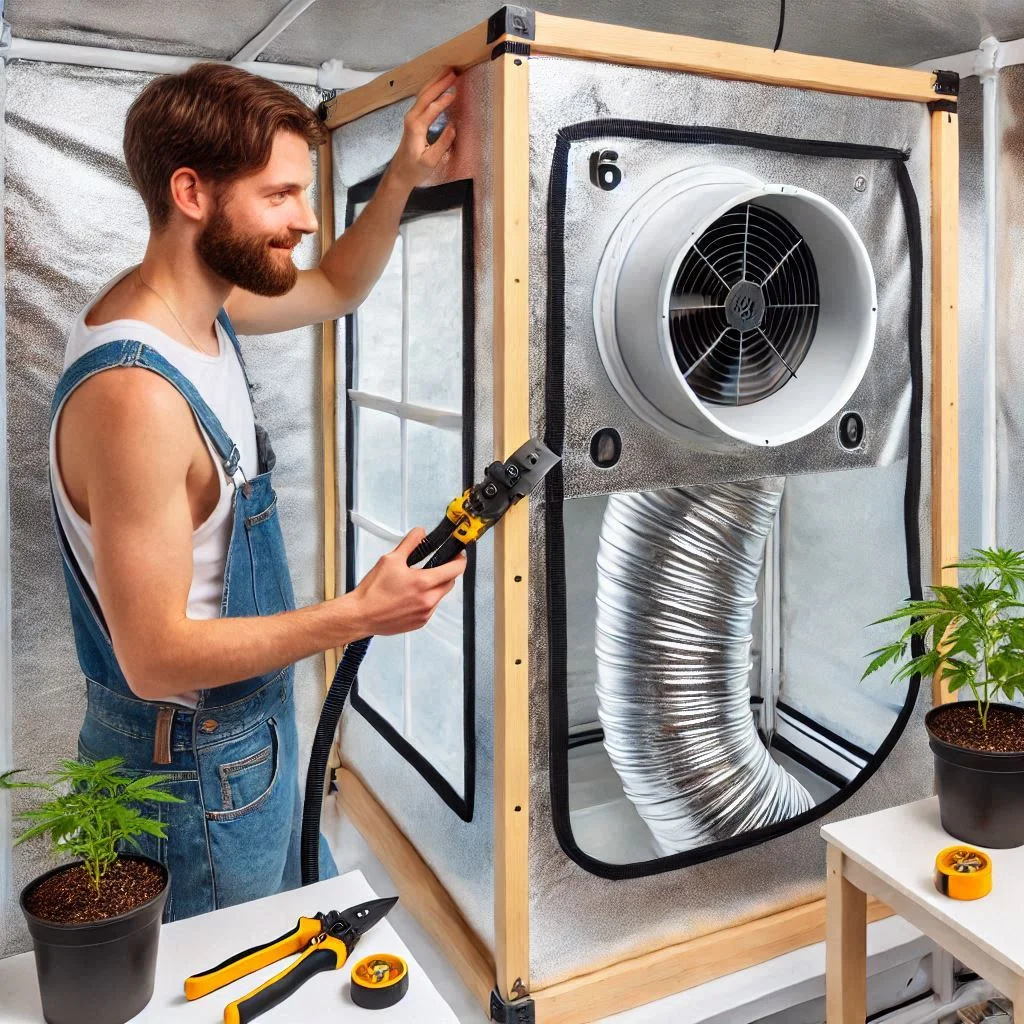
Step 3: Connect the Drainage System (If Applicable)
Many portable air conditioners have a self-evaporating feature, but some require drainage for the condensed water. This water can build up inside the unit as moisture is removed from the air.
- Drain hose: If your AC unit has a drainage feature, connect a drain hose to the designated outlet on the unit. Ensure the hose leads to a drainage container or outside where the water can be disposed of properly.
- Check water levels regularly: If your AC does not have a self-evaporating feature, make sure to drain the water tank frequently to prevent water from accumulating inside the unit.
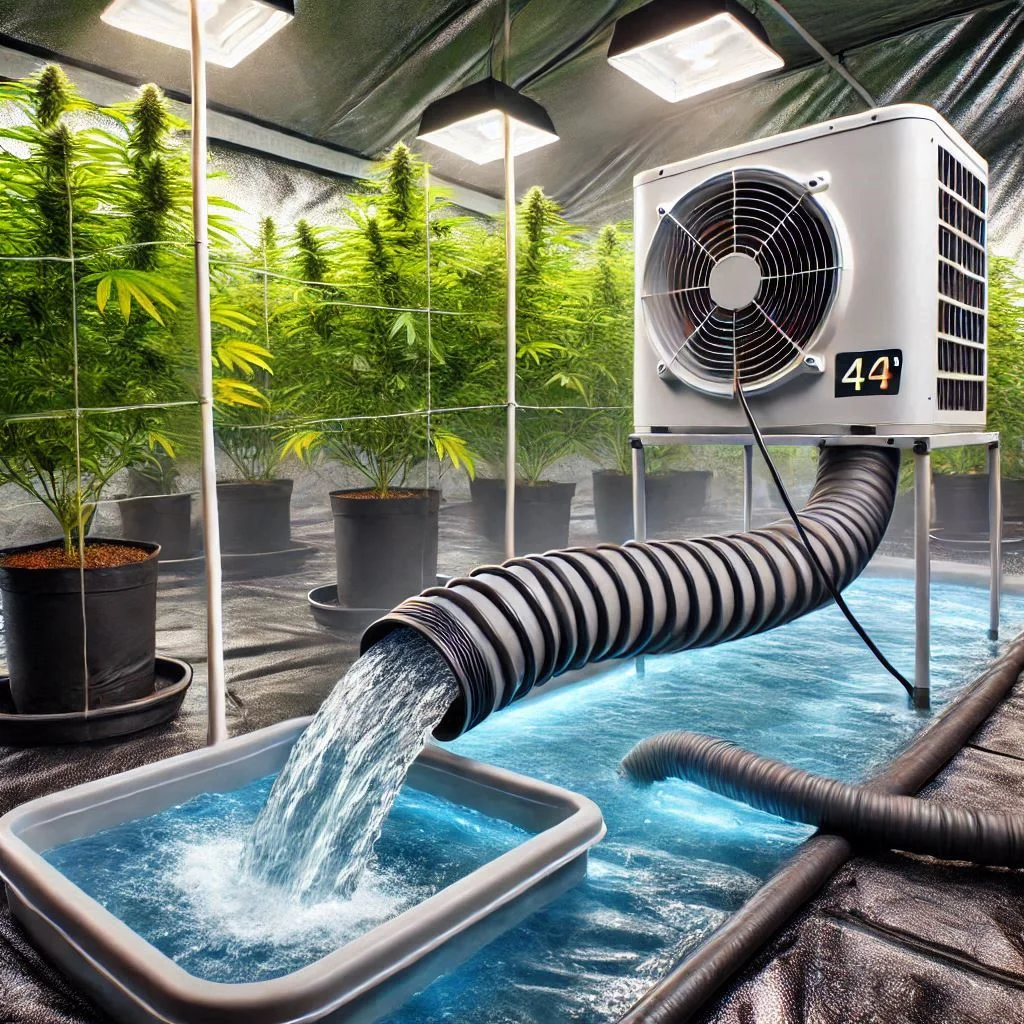
Step 4: Set the Temperature and Airflow Controls
With the portable AC installed and connected, you’re ready to set the temperature and airflow to suit your grow tent’s needs.
- Adjust the temperature: Set the AC to the desired temperature range for your specific plants. Most plants thrive in temperatures between 65°F and 80°F (18°C–27°C), but check the needs of your specific crop.
- Airflow direction: Adjust the louvers or air vents on the AC unit to direct the cool air towards your plants. Ensure that the airflow is evenly distributed throughout the tent for consistent cooling.
- Fan speed settings: Use the fan speed setting to increase airflow when temperatures rise, or decrease it when the environment is cooler. Using a high fan setting during the day and a low fan setting at night can optimize energy efficiency.
Step 5: Monitor and Adjust Settings Regularly
Once everything is set up, it’s important to monitor the performance of your portable AC unit regularly to ensure your grow tent remains within the ideal temperature and humidity range.
- Temperature checks: Use a digital thermometer inside the grow tent to regularly monitor the temperature. Adjust the settings on your portable AC unit if the temperature rises or falls outside of your desired range.
- Humidity control: Some AC units have a built-in dehumidifier feature. If yours doesn’t, you may want to use a separate humidifier or dehumidifier to help control moisture levels in the tent.
Tips for Maximizing Efficiency and Airflow
To ensure your portable air conditioner operates at its best and provides maximum efficiency, consider the following tips:
- Seal any gaps in the tent: Ensure that the grow tent is properly sealed to prevent cool air from escaping and hot air from entering. Use duct tape or weatherstripping to close any openings around windows, vents, or zippers.
- Use reflective materials: Place reflective materials such as Mylar or reflective plastic around the inside of the tent. These materials will bounce cool air around, improving airflow and cooling efficiency.
- Use a fan: Adding an oscillating fan inside the tent helps distribute cool air more evenly, reducing the strain on your AC unit and improving airflow.
- Clean the AC unit regularly: Dust and dirt can clog filters and vents, reducing the efficiency of your portable AC. Clean the unit’s filters regularly to maintain airflow and efficiency.
Common Issues with Portable Air Conditioners for Grow Tents and How to Solve Them
Portable air conditioners are an excellent choice for regulating temperature and humidity in grow tents, but like any appliance, they can sometimes experience issues that affect their performance. In this section, we’ll address common problems that you might face with a portable air conditioner in your grow tent and provide solutions to help you resolve them. These tips will help you maximize efficiency and ensure your grow tent remains in optimal condition for your plants.
1. Dealing with Insufficient Cooling
One of the most common issues with portable air conditioners in grow tents is insufficient cooling. This can occur for several reasons, and resolving it often requires addressing one or more factors that affect performance.
- Causes of Insufficient Cooling:
- Undersized AC unit: If the portable AC unit has a lower cooling capacity (BTU) than necessary for the size of your grow tent, it won’t be able to maintain the desired temperature.
- Improper placement: The AC unit might not be positioned optimally to provide adequate airflow and cooling. Ensure the exhaust hose is venting hot air outside and not allowing it to re-enter the tent.
- Ventilation issues: Blocked air vents or poor airflow can impede the AC’s efficiency. If the AC is surrounded by obstructions, the airflow may be restricted.
- Solutions:
- Choose the right cooling capacity: Ensure your portable AC has a sufficient BTU rating for your grow tent size. For instance, a 10,000 BTU AC unit is typically sufficient for tents around 200–400 sq. ft, while larger tents (up to 500 sq. ft) may require a 14,000 BTU unit.
- Check hose installation: Make sure the exhaust hose is properly installed and venting hot air outside. If possible, shorten the length of the exhaust hose for better efficiency.
- Optimize air circulation: Use oscillating fans inside the tent to help distribute cool air evenly, and avoid blocking the air intake or exhaust vents.

2. Addressing Noise and Condensation Problems
Portable air conditioners can sometimes create noise and deal with condensation issues. While noise is an inherent characteristic of many AC units, excessive noise and water buildup can become problematic for both your comfort and the unit’s efficiency.
- Noise Problems:
- Excessive noise can disturb your environment and potentially affect your plants. The noise usually comes from the compressor or fan running at high speed.
- Condensation Problems:
- Condensation occurs when moisture from the air is removed by the AC unit. This can lead to water buildup inside the unit or on the floor of the tent, which can increase humidity levels and affect plant health.
- Solutions:
- Reducing Noise:
- Use a noise-reducing cover for the AC unit to help dampen the sound. Ensure that the AC unit is placed on a soft surface, such as a rubber mat, to reduce vibrations.
- Place the AC unit on a flat surface and check if it’s properly aligned to reduce excessive noise.
- Managing Condensation:
- Use a self-evaporating model: If possible, opt for an AC unit with a self-evaporating feature, which reduces the need for manual draining and helps keep the humidity level stable.
- Drain the excess water: For units without self-evaporation, regularly empty the water collection tray to prevent excessive moisture buildup.
- Install a drainage hose: Connect a drainage hose to the unit to allow excess moisture to flow out of the grow tent, keeping the humidity levels under control.
- Reducing Noise:
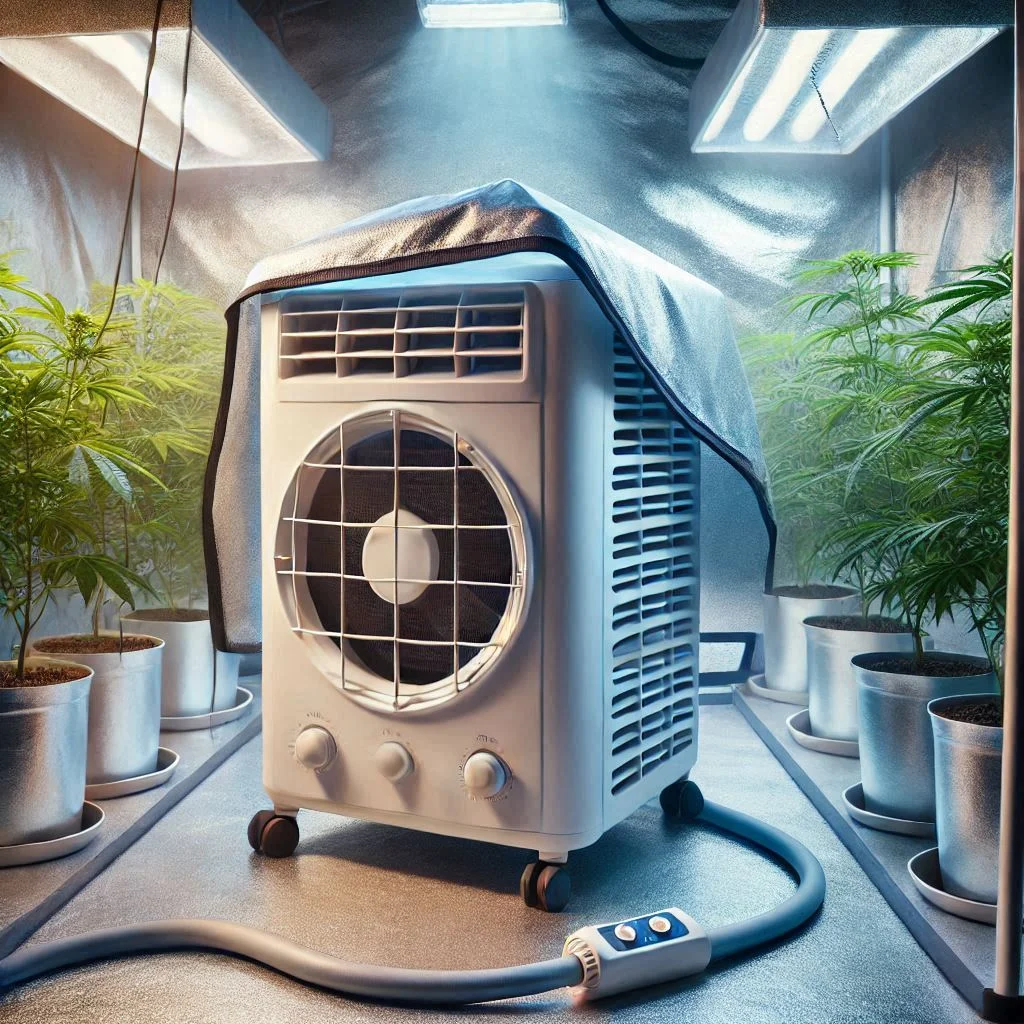
3. Regular Maintenance Tips to Keep Your AC Running Efficiently
Proper maintenance of your portable air conditioner is essential to ensure its long-term performance and efficiency. Regular upkeep will not only extend the life of the unit but also ensure that it functions at its best for cooling your grow tent.
- Maintenance Tasks:
- Cleaning filters: Dirty filters can reduce the airflow and cooling capacity of the AC. It’s important to clean or replace the filters regularly (every 1-2 weeks, depending on usage).
- Checking the exhaust hose: Over time, exhaust hoses may become clogged or kinked, restricting airflow. Inspect and clean the hose regularly to ensure there are no blockages.
- Inspecting the unit for leaks: Check for any visible leaks or damaged parts, particularly around the drain hose and vents. If you notice any issues, fix them immediately to prevent further damage.
- Best Practices for Maintenance:
- Regularly empty the water collection tank (if applicable) to prevent overflow or excessive humidity buildup.
- Unclog the drain hole if you notice water pooling around the unit.
- Perform a deep clean at the end of each growing cycle to ensure the AC is in top condition for the next use.
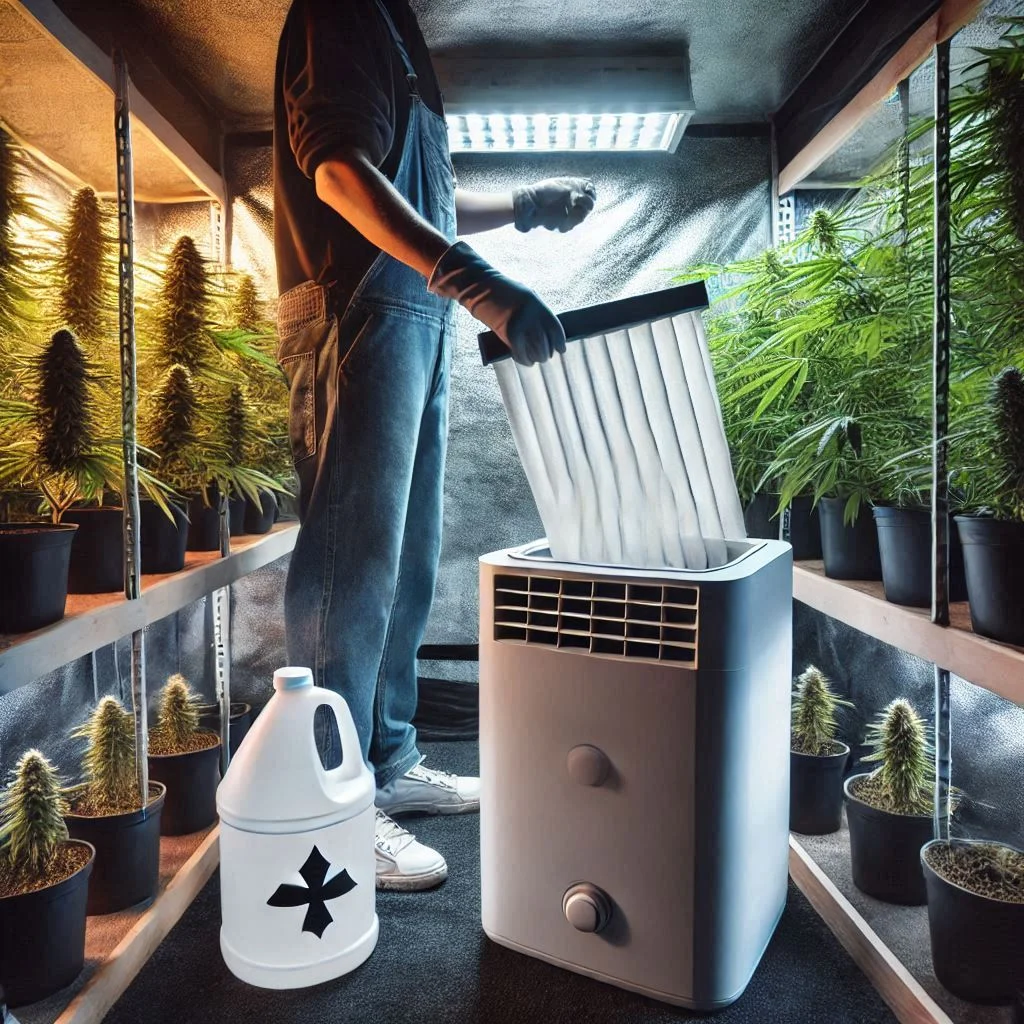
How to Choose the Right Size Portable Air Conditioner for Your Grow Tent
Choosing the right size portable air conditioner (AC) for your grow tent is crucial to maintaining an optimal environment for your plants. Too small of an AC unit will struggle to cool the space, while too large of a unit may cause issues with humidity levels and lead to unnecessary energy consumption. In this guide, we’ll walk you through the factors that influence the size of the portable AC you need and how to calculate the appropriate BTU (British Thermal Units) rating for your grow tent.
1. Factors That Influence Size: Tent Size, Plants, and Ambient Temperature
Several factors play a role in determining the right portable air conditioner size for your grow tent. Understanding these factors will help you choose the most efficient unit for your space.
- Tent Size:
- The size of your grow tent is one of the most significant factors influencing the size of the portable AC unit you need. Larger tents require units with higher BTU ratings to effectively cool the air.
- For smaller tents (under 100 sq. ft), an AC with a 6,000–8,000 BTU rating may be sufficient. However, for larger tents (up to 400 sq. ft or more), you’ll need a unit with a 10,000–14,000 BTU rating.
- Plants and Light Equipment:
- Plant activity and lighting equipment generate heat, which will increase the load on the AC unit. If you’re using powerful grow lights (like HPS or LED), they can raise the temperature in the tent, meaning you’ll need a more powerful AC unit.
- The number of plants in the tent also affects the cooling needs, as more plants will release additional moisture and heat. Therefore, larger grow areas with denser plant setups may need a more powerful AC.
- Ambient Temperature:
- The ambient temperature of the room where your grow tent is located will also impact your choice of AC. If the room is already very warm, the AC unit will need to work harder to cool the tent.
- For areas with consistently high ambient temperatures, you may need a larger AC with a higher BTU rating to compensate for the increased heat.
2. Calculating BTUs and Making the Best Choice for Different Grow Tent Sizes
To choose the right size portable air conditioner, you’ll need to calculate the required BTU rating based on the factors mentioned above. The BTU rating represents the unit’s cooling capacity. A higher BTU rating means the AC can cool a larger space.
- Basic BTU Calculation for Tent Size:
- The general rule of thumb is that 1 BTU per square foot of tent space is needed for basic cooling. For example, if your grow tent is 200 sq. ft, you’ll need at least 8,000–10,000 BTUs for efficient cooling.
- For more accurate results, increase the BTU capacity based on additional factors like lighting, plant density, and ambient temperature.
Formula to Estimate BTUs:
- BTUs = Tent Size (sq. ft) x 20
- For example, for a 200 sq. ft tent, you would need at least 4,000 BTUs. However, considering plant activity and lighting, a 10,000 BTU unit might be better suited.
- Adjusting for Lighting and Plants:
- If you have powerful lights like HPS or LED lights, consider adding 2,000–4,000 BTUs for every 1,000 watts of lighting in the tent.
- Similarly, if you have dense plant coverage or a larger number of plants, you may need to add an additional 1,000–2,000 BTUs to the total.
- Sizing for Different Tent Configurations:
- Small Tents (Under 100 sq. ft):
- For a small tent, such as a 2×4 or 3×3 setup, an AC with a 6,000–8,000 BTU rating should be sufficient for basic cooling, considering typical plant setups and ambient conditions.
- Medium Tents (100–200 sq. ft):
- A medium tent, like a 4×4 or 5×5, will typically need 8,000–12,000 BTU units, depending on lighting and plant density.
- Large Tents (200+ sq. ft):
- For larger tents, a 12,000–14,000 BTU AC is ideal, especially if you have multiple light sources or higher ambient temperatures. These units can efficiently cool spaces up to 400 sq. ft or more.
- Small Tents (Under 100 sq. ft):
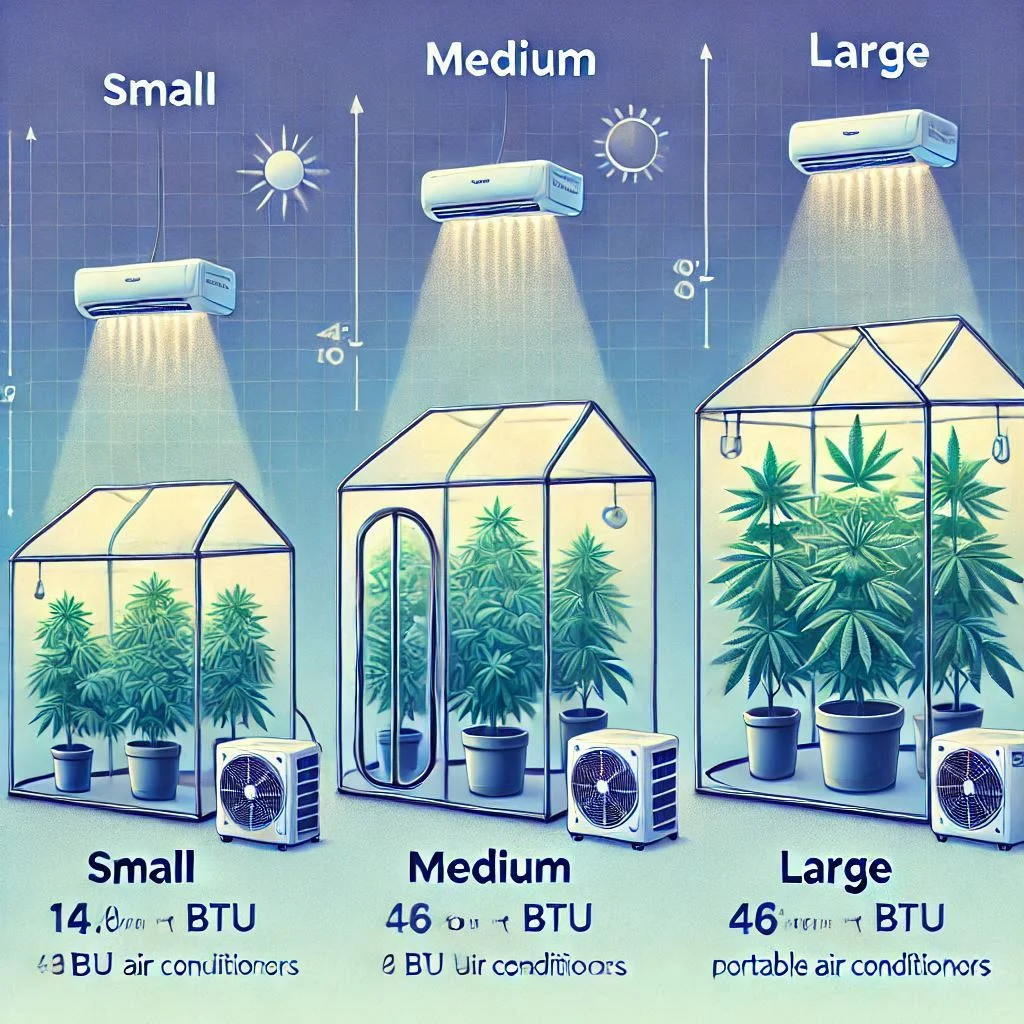
3. Other Considerations When Choosing AC Size
While calculating BTUs is essential, there are additional factors that could influence your decision when selecting a portable air conditioner for your grow tent.
- Energy Efficiency:
Choose an energy-efficient unit with a high SEER rating (Seasonal Energy Efficiency Ratio). Efficient units will reduce your electricity costs, especially if you run the AC for long periods during the growing cycle. - Room Temperature vs Tent Temperature:
If your grow tent is in a room that’s much hotter than normal, the AC unit will have to work harder to cool the tent. In these cases, opting for a slightly larger BTU unit may provide better results, as it can compensate for the higher ambient temperature. - Portable AC Features:
Many portable AC units come with auto mode and dehumidification functions. These features can be useful for maintaining consistent humidity levels inside your grow tent, which is critical for plant health. - Unit Portability and Setup:
Consider how easy it is to move and install the AC unit. A lightweight, compact design can be helpful, especially if you need to adjust the AC unit frequently or relocate it.
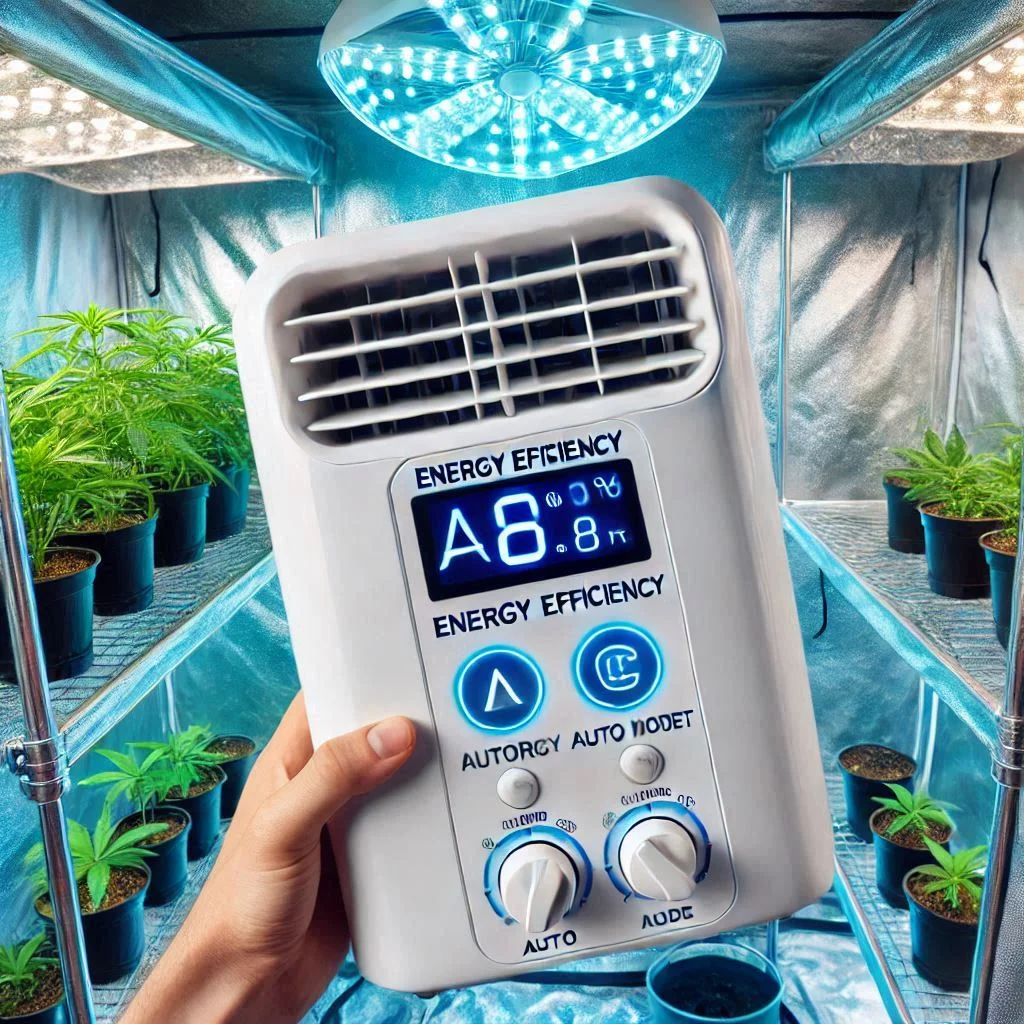
Frequently Asked Questions (FAQs) About the Best Portable Air Conditioners for Grow Tents
In this section, we answer the most frequently asked questions (FAQs) related to selecting, setting up, and maintaining portable air conditioners for grow tents. These answers are designed to provide you with the information you need to make an informed decision and optimize the cooling environment for your plants. Each answer is written with SEO best practices to improve search rankings and visibility on Google.
1. What Size Portable Air Conditioner Do I Need for My Grow Tent?
Choosing the right size for your grow tent depends on the tent size, ambient temperature, plant density, and lighting conditions. To determine the ideal size:
- Small tents (under 100 sq. ft): A portable air conditioner with a 6,000–8,000 BTU rating is generally sufficient.
- Medium tents (100–200 sq. ft): For medium-sized tents, you’ll need 8,000–12,000 BTUs to account for added heat from lights and plants.
- Large tents (200+ sq. ft): Larger tents require 12,000–14,000 BTUs, especially when using powerful lighting systems.
Tips:
- Always factor in additional heat from grow lights and plants when calculating your AC’s cooling capacity. Higher ambient temperatures in the room where your tent is placed will also require a more powerful unit.
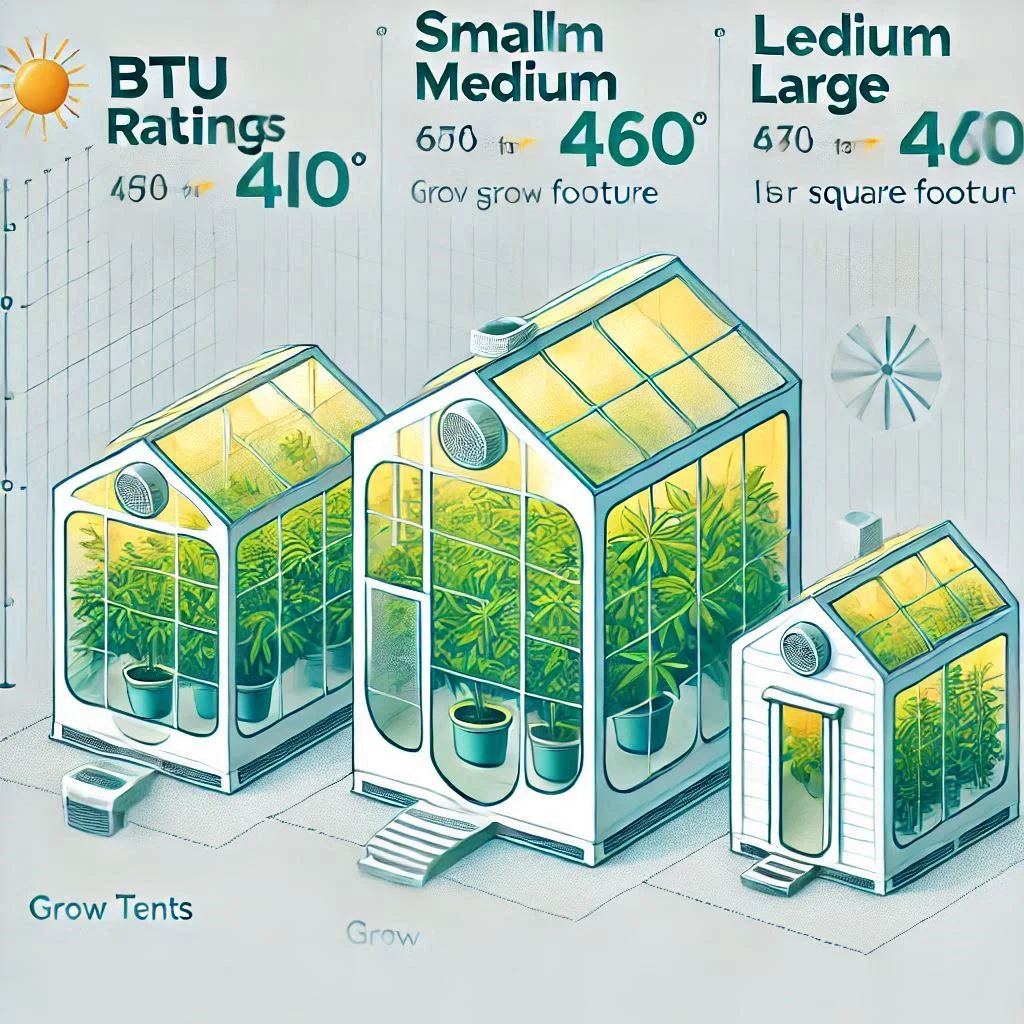
2. How Do I Maintain My Portable Air Conditioner for Optimal Performance?
To ensure your portable air conditioner continues to perform at its best, regular maintenance is key. Here are a few important maintenance tips:
- Clean the filters every 1–2 weeks to ensure smooth airflow and cooling efficiency.
- Check the exhaust hose regularly for any clogs or kinks that may restrict airflow.
- Empty the water collection tank or connect a drainage hose to prevent water buildup and excess humidity inside the tent.
- Inspect for leaks around seals and connections to avoid inefficiencies.
Regular maintenance helps extend the lifespan of the air conditioner and ensures it works effectively, especially during high-demand periods in the growing cycle.
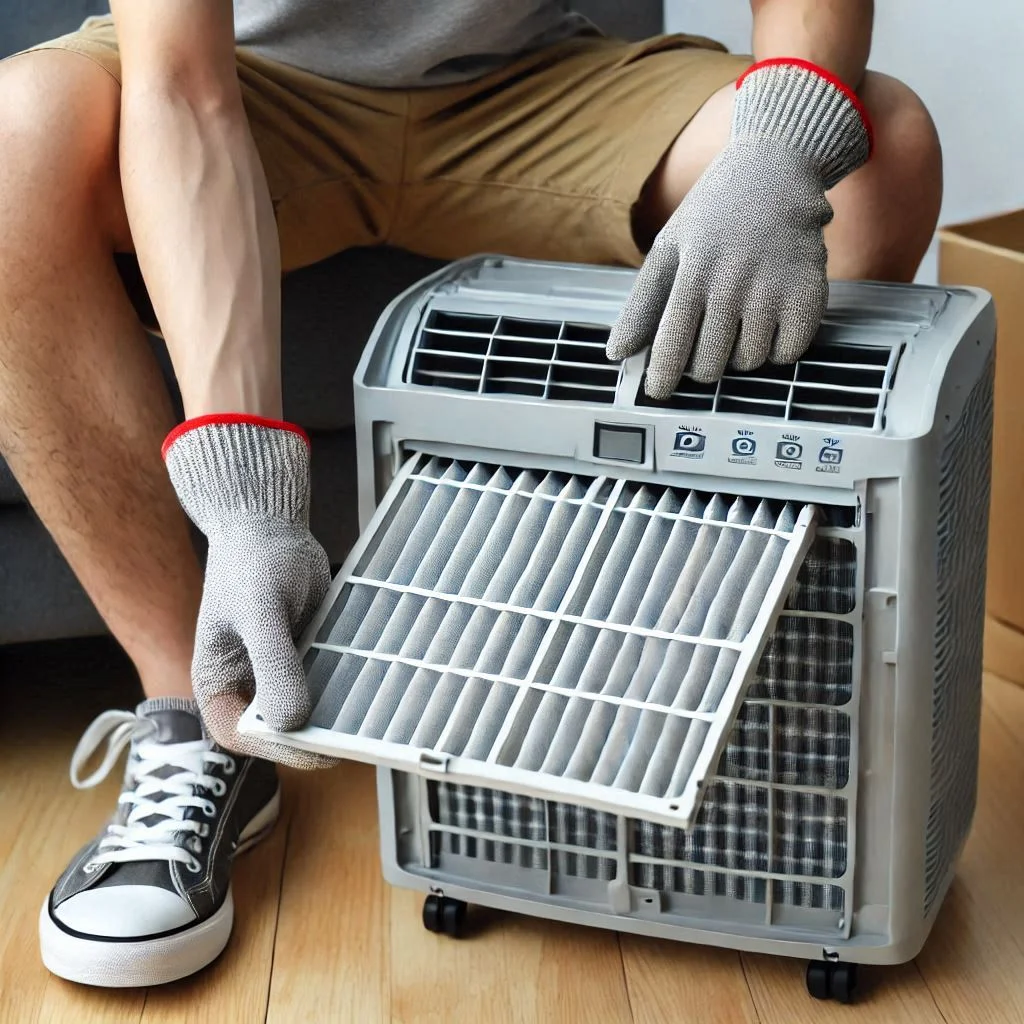
3. Can I Use a Portable Air Conditioner in a Grow Tent with High Humidity?
Yes, portable air conditioners are highly effective in reducing humidity in your grow tent. Many modern portable AC units come with a dehumidification mode that helps remove excess moisture from the air.
- Benefit of Dehumidification:
Removing excess moisture is crucial because high humidity levels can encourage mold growth and reduce the overall health of your plants. By using a portable AC with dehumidification, you’ll maintain an ideal balance of temperature and humidity. - Important Tip:
If you live in a particularly humid climate, consider an AC unit with a higher dehumidification capacity and a self-evaporating feature to handle the additional moisture in the tent.
4. What Are the Benefits of Using a Portable Air Conditioner in a Grow Tent?
Using a portable air conditioner in your grow tent offers several benefits:
- Temperature Control:
It allows you to maintain a consistent temperature, which is critical for the healthy growth of your plants. - Humidity Regulation:
AC units help remove excess moisture, ensuring your tent’s humidity remains within the optimal range (40-60% depending on the plant type). - Energy Efficiency:
Many portable AC units are designed with energy-saving features, allowing you to maintain your tent’s environment without a significant increase in electricity bills. - Portability and Flexibility:
Portable AC units are easy to move and can be relocated as needed to optimize space or airflow in your grow tent.
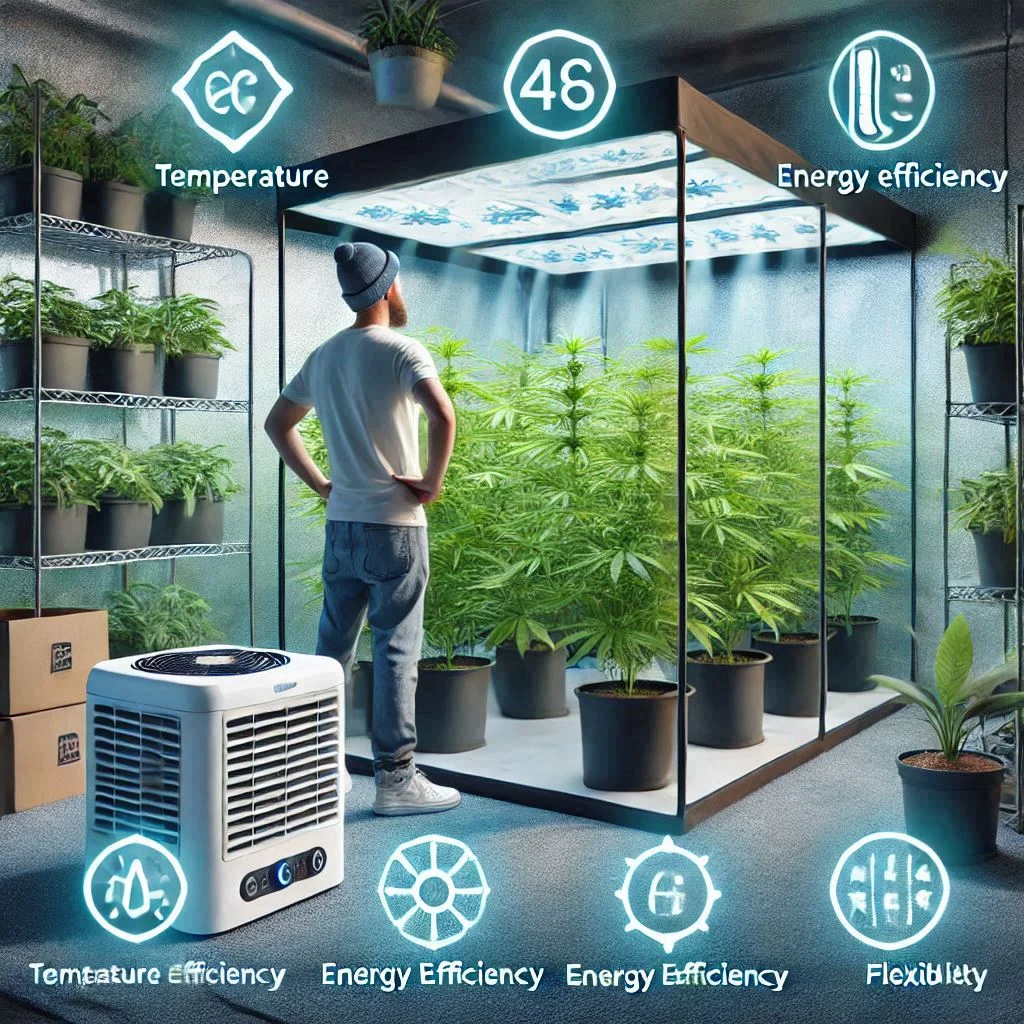
5. How Do I Reduce the Noise from My Portable Air Conditioner in the Grow Tent?
Noise can be a concern when using portable air conditioners in grow tents, especially if you’re operating the unit for long periods. Here’s how to minimize the noise:
- Use Noise-Reducing Covers:
Many portable AC units have noise-reducing covers or cases available, which can help dampen the sound. - Place the AC on a Soft Surface:
Putting the air conditioner on a rubber mat or other soft material can reduce vibrations that contribute to noise. - Opt for Low-Noise Models:
Some portable AC models are specifically designed to be quieter. Check the decibel rating of the unit before purchasing, and choose a model that offers quieter operation for a more peaceful environment.
6. Is It Safe to Leave My Portable Air Conditioner Running All Day in a Grow Tent?
Yes, it is generally safe to leave a portable air conditioner running all day, especially in auto mode. However, there are a few things to keep in mind:
- Choose a unit with a continuous drainage option:
If your portable AC has a water collection tank, ensure it is emptied regularly or use a continuous drainage hose to avoid water buildup. - Monitor energy consumption:
Running the AC unit for long periods can increase your energy costs. If energy consumption is a concern, opt for an energy-efficient model with a high SEER rating. - Ensure proper ventilation:
Ensure that the exhaust hose is properly vented to the outside and that there are no obstructions around the AC unit to prevent overheating.

Conclusion
In conclusion, choosing the best portable air conditioner for your grow tent is essential for maintaining a healthy and productive growing environment for your plants. By understanding factors like tent size, ambient temperature, and plant density, you can select the right AC unit with the appropriate BTU rating to ensure optimal cooling and humidity control. Regular maintenance, proper setup, and the right sizing can significantly improve the efficiency and longevity of your portable AC. With the information provided in this guide, you are now equipped to make an informed decision and enhance the performance of your grow tent. Keep your plants cool, healthy, and thriving with the right air conditioning solution—ensuring successful growth cycles year-round.
This blog is packed with actionable insights that aim to improve your grow tent’s environment, ultimately boosting plant health and productivity. By following these steps and using the tips mentioned, you’re on your way to mastering temperature and humidity control with the best portable air conditioner for your grow tent.

